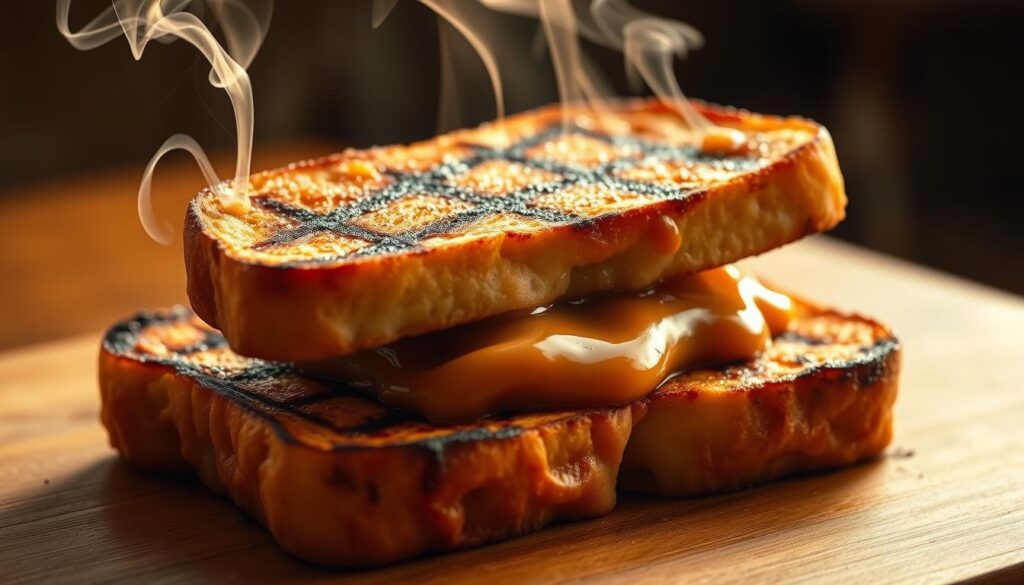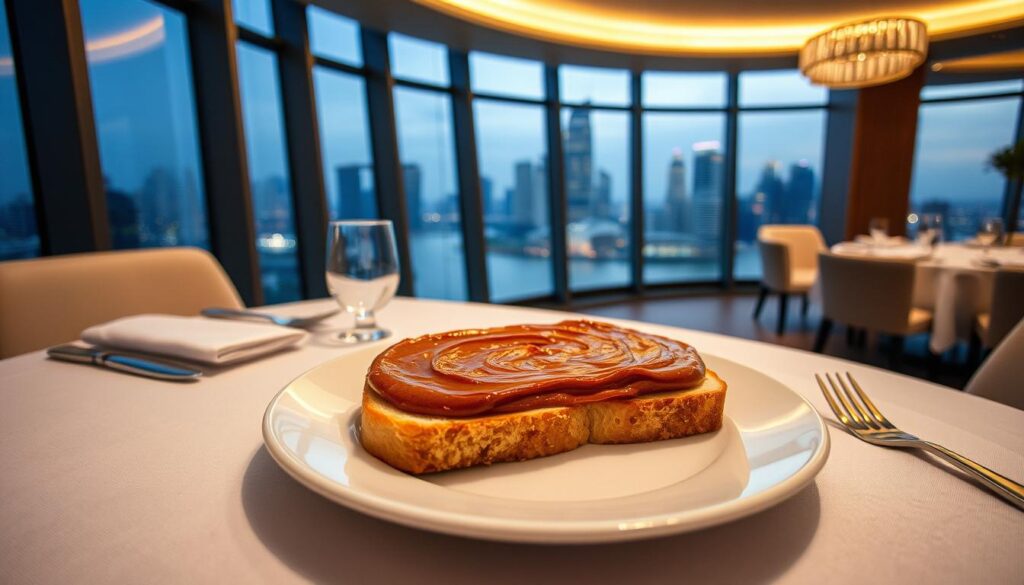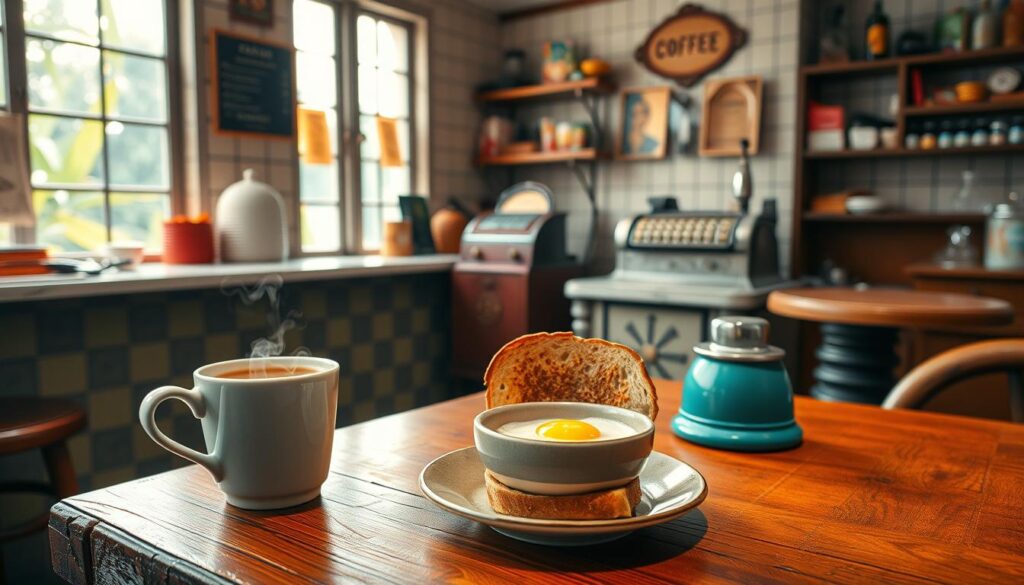Singapore’s breakfast scene thrives on rich flavors and cultural heritage. Among its staples, kaya toast stands out as a beloved morning ritual. This sweet, coconut-based spread paired with crispy bread and soft-boiled eggs offers a taste of tradition.
This guide explores both classic and creative takes on the dish. From decades-old coffee shops to trendy cafes, each spot brings something special. Expect hidden gems, fusion twists, and time-tested recipes.
Whether you’re a local or a visitor, these selections promise an authentic experience. We’ve included practical details to help you plan your visit. Get ready to discover why this simple dish holds such cultural significance.
Key Takeaways
- Singapore’s breakfast culture celebrates kaya toast as a signature dish.
- The list includes heritage spots and modern interpretations.
- Unique variations like foie gras and sourdough are featured.
- Locations range from hidden gems to well-known establishments.
- Each entry includes practical details for easy planning.
Introduction to Kaya Toast: A Singaporean Breakfast Staple
Few dishes capture Singapore’s culinary soul like this sweet, fragrant breakfast dish. More than just food, it’s a morning ritual passed down through generations.
What Is Kaya Toast?
This iconic treat features a coconut-jam spread (kaya) sandwiched between toasted bread. Hainanese immigrants created it in the early 1900s, blending local ingredients with their techniques. Two main varieties exist:
- Brown Hainanese: Caramelized sugar gives a deep, smoky sweetness.
- Green Nyonya: Pandan leaves add floral notes and vibrant color.
Pioneers like Ya Kun (1944) and Kheng Hoe Heng (1919) perfected the recipe in humble coffee shops, serving it with kopi and soft-boiled eggs drizzled with soy sauce.
Why Is It a Must-Try?
UNESCO lists Singapore’s hawker culture as intangible heritage, and this dish is its star. Locals swear by the ritual—crisp bread dipped in runny eggs, followed by a sip of tea. Even Nat Geo called it
“a symphony of textures and contrasts.”
Modern twists like sourdough or foie gras exist, but nothing beats the traditional kaya toast’s simplicity. For visitors, skipping it would be like missing the Eiffel Tower in Paris.
1. YY Kafei Dian: A Nostalgic Kopitiam Experience
Step into a time capsule of flavors at YY Kafei Dian, where every bite tells a story. This retro spot on Beach Road transports you to the 1990s with its green tiles and marble tables. It’s a love letter to Hainanese coffee culture, served with a side of warmth.
Signature Kaya Butter Bun
The star here isn’t ordinary toast—it’s their airy buns with a crisp crust. Slathered with traditional kaya and a slab of cold butter, each bite melts in your mouth. At S$1.30, it’s a steal for the rich, caramelized flavor.
Regulars rave about the kaya’s generous portion. Pair it with a kopi set for the full experience. Unlike chain cafes, YY’s buns stay pillowy-soft for hours.
Retro Ambiance and Location
Every corner feels like a vintage postcard—checkered floors, old-school posters, and slow ceiling fans. It’s Instagram gold, but the real charm is in the unhurried pace.
Find it at 37 Beach Road, a short walk from Bugis MRT. Come weekdays before 10 AM to skip the crowd. Compared to Heap Seng Leong, YY feels more polished but just as authentic.
For a breakfast dish that’s equal parts hearty and historic, YY Kafei Dian hits all the right notes.
2. Homeground Coffee Roasters: Modern Twist on a Classic
A heritage shophouse on Joo Chiat Road hides a modern breakfast gem. Homeground Coffee Roasters reimagines the kaya toast set with precision techniques and premium ingredients. Think sous vide eggs and French butter—worth every penny of the S$9.50 price tag.
“Atas” Kaya Toast with Sous Vide Egg
The star here is the crackling toast, layered with house-made kaya and chilled French butter. A 63°C sous vide egg adds silkiness, contrasting with the crisp bread. Chef Wei’s philosophy?
“Respect tradition, but don’t fear innovation.”
Portions are generous compared to chain cafes. Skip the Instagram hype—the real magic is in the textures: creamy, crunchy, and velvety in one bite.
Brunch-Friendly Setting
Weekends draw crowds for their deconstructed presentation and single-origin coffee pairings. Try the Ethiopia Yirgacheffe for floral notes that complement the kaya’s sweetness.
Parking tips: Arrive before 9 AM or use nearby east coast bike shares. Groups can explore alternative dishes like matcha waffles or truffle scrambled eggs.
3. Ah Seng (Hai Nam) Coffee: Charcoal-Grilled Perfection
At Maxwell Food Centre, smoke from charcoal grills signals where magic happens. This mother-son stall, Ah Seng (Hai Nam) Coffee, turns simple ingredients into a breakfast masterpiece. Their secret? A decades-old recipe and relentless attention to heat.

Kaya French Toast with Eggy Goodness
For S$4, their kaya french toast delivers bold contrasts. Thick-cut bread soaks in egg batter before hitting the grill, gaining a caramelized crust. Pandan-infused green kaya oozes coconut richness, balanced by cold butter slices.
Unlike Western versions, Ah Seng’s toast leans savory-sweet. Regulars swear by the kopi pairing—its bitterness cuts through the jam’s sweetness. Arrive by 7:30 AM to beat the CBD worker rush.
Family-Run Legacy
Since 1980, the same family-run team has manned the grill. Their charcoal technique—passed through generations—gives the toast its smoky depth. “We won’t switch to gas,” the son says. “The flavor dies otherwise.”
Despite expansion offers, they prioritize quality over scale. Catering orders (for offices) keep traditions alive. Try combo sets with local dishes like nasi lemak for a full experience.
4. Micro Bakery: Sourdough Meets Kaya
A crusty sourdough loaf meets fragrant pandan jam in this east coast bakery’s signature twist. At Serene Centre, bakers blend 48-hour fermented dough with house-churned coconut spread for S$7—a worthy upgrade from traditional versions.
Unique Sourdough Kaya Toast
The slow fermentation creates airy pockets that soak up pandan kaya beautifully. Flaky sea salt on top enhances the textures, balancing sweetness with savory notes. Gluten-free options use rice flour blends without compromising crispness.
Chef-owner Rajah (ex-Tippling Club) applies French techniques to local flavors. Seasonal variations might include gula melaka swirls or yuzu-infused kaya. Their specialty single-origin coffee cuts through the richness perfectly.
Artisanal Bakery Vibes
Exposed brick walls and flour-dusted counters set the scene. Takeaway boxes use compostable materials—part of their zero-waste mission. Arrive before 11 AM for warm loaves paired with kouign-amann or almond croissants.
Dual locations operate at Serene Centre (7 AM–3 PM) and Katong (8 AM–4 PM). Though pricier than kopitiam sets, the craftsmanship justifies the cost. As regulars say:
“It’s like hearing your favorite song remixed by a jazz musician.”
5. Spago Dining Room: Luxurious Kaya Toast
Elevating a humble breakfast dish to Michelin-worthy heights, Spago Dining Room redefines indulgence. Perched on Marina Bay Sands’ 57th floor, Wolfgang Puck’s Asian-inspired menu features a foie gras and kaya fusion that sparks both awe and debate.

Foie Gras and Kaya Toast Fusion
The S$10 add-on transforms the classic into a fine dining course. Silky foie gras melds with pandan-infused jam, topped with espresso sorbet for a bitter-sweet finish. Critics argue it strays from tradition, but Puck defends it:
“Fusion isn’t about replacing heritage—it’s about celebrating it through new lenses.”
Presentation rivals art: gold-leaf dusted plates, edible flowers, and smoke-filled cloches. Portions are smaller than kopitiam servings, but the layered flavors justify the price.
Fine Dining Experience
Dress codes apply (smart casual), and reservations are essential for window seats overlooking Marina Bay. Pair the dish with a Gewürztraminer wine—its lychee notes complement the kaya’s sweetness.
| Feature | Spago Dining Room | Typical Hotel Breakfast |
|---|---|---|
| Price | S$10 add-on | Included in buffet |
| Atmosphere | Skyline views, white-glove service | Casual, buffet lines |
| Uniqueness | Celebrity chef twist | Standard international fare |
Ideal for anniversaries or impressing clients, Spago’s version is less about nostalgia and more about luxury reimagined. Arrive at 8 AM for golden-hour photos sans crowds.
6. Chin Mee Chin Confectionery: A Heritage Revival
A beloved institution rises like a phoenix in Katong, blending old-world charm with fresh energy. After careful restoration by Ebb & Flow Group, this 1925 treasure reopened in 2023 with its soul intact. The pastel green facade now houses modern comforts while preserving nostalgic flavors.
Crispy Toast with Homemade Kaya
Their signature S$2.20 toast discs crackle with perfection, still charcoal-grilled like in the founders’ era. What makes them special?
- Original 1925 recipe: Pandan-infused homemade kaya uses the same coconut-to-egg ratio
- Textural contrast: Paper-thin crispness gives way to pillowy centers
- Daily freshness: Bakers start at 4 AM for that just-toasted quality
Limited edition seasonal versions sometimes appear, like gula melaka swirls during festive periods. The kaya-making demonstrations every Saturday let visitors witness tradition in action.
East Coast Charm
The expanded 50-seat space balances vintage tiles with Instagram-friendly lighting. Management kept 90% of the original menu while adding discreet upgrades:
| Before Revival | After Revival |
|---|---|
| Cash-only payments | Contactless options available |
| No photography policy | Encouraged social media sharing |
| 6 AM sell-outs | Extended hours till 3 PM |
Weekend mornings draw crowds, so arrive before 9 AM. Parking can be tricky—consider the nearby east coast park connector if driving. Regulars appreciate how CEO Lim Kian Chun honored the third-generation owners’ legacy while making it accessible for new audiences.
Compared to neighboring eateries, Chin Mee Chin stands out for resisting franchise offers to maintain authenticity. As one patron noted:
“It’s rare to see a heritage spot revived without losing its heartbeat.”
7. Heap Seng Leong: A Blast from the Past
Time stands still at this corner kopitiam, where every creaky wooden chair tells a story. Since 1950, Heap Seng Leong has served its famous S$3.60 set—thick traditional kaya toast paired with Kopi Gu You (butter coffee). The Lavender location near historic shophouses makes it a living museum of Singapore’s coffee culture.

Traditional Kaya Toast Set
Their secret lies in the butter coffee preparation. Thick slabs of cold butter sink slowly into hot kopi, creating a creamy layer. Regulars swear by the ritual—first sip the coffee through the butter, then dip the crispy toast.
Portions remain unchanged since the 1980s, defying inflation. The owner, Mr. Tan, explains:
“We’d rather earn less than change what our grandfathers built.”
Old-School Kopitiam Vibes
Original 1950s furniture survives here—mismatched stools, cracked marble tables, and a manual cash register. Film crews frequently visit to capture the authentic nostalgia, most recently for a documentary on vanishing trades.
| Aspect | 1950s | Today |
|---|---|---|
| Toast Set Price | S$0.30 | S$3.60 |
| Butter Source | Local dairy | New Zealand imports |
| Customer Base | Factory workers | Food bloggers + regulars |
Nearby attractions like the 1980s-style Zhongshan Mall complete the time-travel experience. Come weekdays before 8 AM—this cash-only institution closes once the last regular leaves.
8. Sen Yen Charcoal Traditional Toast: Affordable and Authentic
Amidst the hum of Sin Ming’s industrial zone, a modest stall keeps tradition alive with smoky aromas. Sen Yen has perfected the art of charcoal-grilled breakfasts since 1987, offering slices at just S$0.70—a rarity in today’s market.
Charcoal-Grilled French Toast
Their signature item uses thick-cut bread dipped in egg batter before hitting the grill. Unlike regular versions, the charcoal heat adds a caramelized crust that locks in pandan kaya’s floral sweetness.
Regulars debate two preparation styles:
- Classic: Thin, crisp slices with kaya-butter layers
- French: Egg-coated for richer texture
Both come with soy-drizzled eggs. The French style costs S$1.20 but offers more heft.
No-Frills Coffee Shop Setting
Expect plastic stools and laminated menus at this coffee shop. Takeaway packaging uses greaseproof paper—eco-friendly yet practical for nearby office workers.
Weekday mornings see factory staff grabbing quick bites. Weekends attract families exploring the industrial area’s hidden eateries. Cash payments only keep overheads low.
“We tried gas grills once—customers complained the toast lost its soul,” admits the third-generation owner.
Health-conscious diners appreciate the minimal oil usage. The stall’s small scale ensures quality control, though it limits expansion. Pair your meal with local lunch options from neighboring stalls for a full experience.
9. Tong Ah Eating House: Keong Saik’s Iconic Spot
Behind art deco façades lies a breakfast institution that survived war, relocation, and gentrification. Tong Ah has anchored Keong Saik Road since 1939, serving its famous S$5.40 set through neighborhood transformations. Today, it shares the block with cocktail bars like Potato Head—a study in contrasts.

Crispy Thin Toast and French Toast Options
The star remains their signature thin toast, achieving a shattering crispness few replicate. Two preparation styles draw loyalists:
- Classic: Paper-thin slices with kaya-butter layers that amplify textures
- French: Egg-dipped for richer mouthfeel, served with runny eggs
Night brings a surprise—the same grill makes savory French toast with luncheon meat. Portions have stayed consistent since the 1980s, defying shrinkflation.
Historic Location
After moving across the street in 2003, the new space preserved original tiles and marble tables. Film crews frequent the spot—keep an eye out for celebrity chefs grabbing late-night suppers.
| Original Location (1939-2003) | Current Spot (Since 2003) |
|---|---|
| No air-conditioning | Cooling available |
| Charcoal grill only | Added gas backup |
| Workers’ breakfast hub | Tourist-friendly menus |
Parking tips: Use nearby Keong Saik roadside lots before 8 AM. The shop connects to the Jalan Besar heritage trail—perfect for post-meal walks. As fourth-generation owner Lim Wei Han notes:
“We’re not a museum piece. We’re living history you can taste.”
10. Keng Wah Sung Cafe: Hidden Gem in Geylang
Generations of regulars swear by the golden-brown perfection at this unassuming Geylang spot. Unlike flashy chains, Keng Wah Sung thrives on simplicity—just S$3.60 sets served by silver-haired staff who remember every customer’s usual order.
The “Perfect Toast” Claim Tested
Their self-proclaimed title holds up under scrutiny. The secret? Bread grilled to a precise crispness that cracks audibly yet stays fluffy inside. Third-generation owner Mr. Lim explains:
“We reject modern shortcuts—same charcoal grill since 1972, same kaya recipe from my grandmother.”
Compared to 24-hour chains, the texture stands out. Thicker than Ya Kun’s version but lighter than French toast, it achieves balance. Regulars customize thickness and kaya quantity—a rare flexibility in traditional spots.
Night Owl Nostalgia
Open until 11 PM daily, it’s a hidden gem for late-night cravings. The 1980s-era tiles and handwritten menus amplify the nostalgic vibe. Safety tip: Stick to well-lit Lorong 27 and avoid alley shortcuts after dark.
Neighboring cultural sites like Geylang Serai Market enrich visits. Multilingual staff accommodate orders in Hokkien, Mandarin, or English. Takeaway packaging uses retro wax paper—perfect for enjoying at nearby Paya Lebar Square.
| Feature | Keng Wah Sung | 24-Hour Chains |
|---|---|---|
| Price | S$3.60 | S$5+ |
| Customization | Toast thickness, kaya amount | Standardized |
| Atmosphere | Family-run charm | Corporate consistency |
Cash-only policy keeps overheads low. For an authentic taste of old-school Geylang before its rapid modernization, this spot delivers.
Conclusion: Savor the Best Kaya Toast in Singapore
From smoky charcoal grills to sky-high fine dining, this journey proves how versatile one dish can be. Whether you prefer Heap Seng Leong‘s butter coffee ritual or modern sourdough versions, each spot adds its own chapter to the story.
The true magic lies in how traditional kaya bridges generations. Early workers dipped crispy bread in kopi, while today’s foodies pair it with single-origin brews. This evolution keeps the culture alive.
Pro tip: Try the french toast variations at Ah Seng or Sen Yen for textural surprises. Most spots serve all day, but mornings offer the full experience. Don’t forget to explore beyond this list—hidden gems await in every neighborhood.



